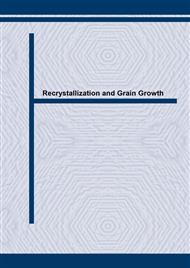p.1175
p.1181
p.1187
p.1193
p.1199
p.1205
p.1211
p.1217
p.1223
Geometric Dynamic Recrystallization in an AA2219 Alloy Deformed to Large Strains at an Elevated Temperature
Abstract:
The mechanism of new grain evolution during equal channel angular extrusion (ECAE) up to a total strain of ~12 in an Al-Cu-Mn-Zr alloy at a temperature of 475oC (0.75Tm) was examined. It was shown that the new grains with an average size of about 15 µm result from a specific process of geometric dynamic recrystallization (GRX) which can be considered as a type of continuous dynamic recrystallization (CDRX). This process involves three elementary mechanisms. At moderate strains, extensive elongation of initial grains takes place; old grain boundaries become progressively serrated. Upon further ECAE processing, transverse low-angle boundaries (LAB) with misorientation ranging from 5 to 15o are evolved between grain boundary irregularities subdividing the initial elongated grains on crystallites with essentially equiaxed shape. The misorientation of these transverse subboundaries rapidly increases with increasing strain, resulting in the formation of true recrystallized grains outlined by high-angle boundaries from all sides. In the same time, the average misorientation of deformation-induced boundaries remains essentially unchanged during ECAE. It is caused by the fact that the evolution of LABs with misorientation less than 4o occurs continuously during severe plastic deformation. The mechanism maintaining the stability of the transverse subboundaries that is a prerequisite condition for their further transformation into highangle boundaries (HABs) is discussed.
Info:
Periodical:
Pages:
1199-1204
Citation:
Online since:
October 2004
Authors:
Price:
Сopyright:
© 2004 Trans Tech Publications Ltd. All Rights Reserved
Share:
Citation:


